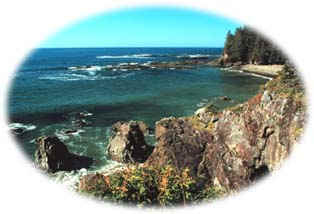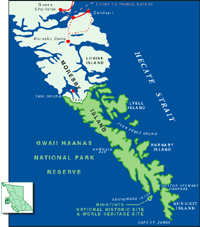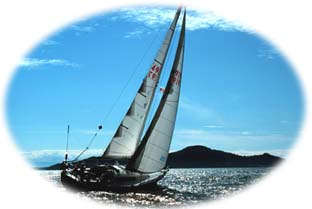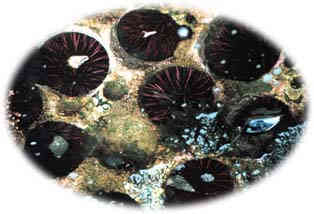|
|
 |
|
|
|
 The Haida Gwaii (Queen Charlotte Islands) Archipelago consists of 138 islands, situated 130 km (80 mi) west of the rugged northern mainland coast of British Columbia. The Haida Gwaii (Queen Charlotte Islands) Archipelago consists of 138 islands, situated 130 km (80 mi) west of the rugged northern mainland coast of British Columbia.
Such famous artists as Emily Carr and Bill Reid have spent time in the area, and conveyed the mystique of the region in their art. In the language of the native Haida residents, "Gwaii Haanas" (South Moresby) means "islands of beauty and wonder", an apt name for this magical place. This region is tremendously important to the Haida First Nations, who have long called Haida Gwaii home.
Not only are the southern islands of great spiritual importance, but Gwaii Haanas is also an integral part of the Haida peoples lives and traditions. This region initially received national public attention when more than 75 Haida elders were arrested while attempting to block logging operations on Lyell Island. After years of struggle by the native people and environmental groups, the region was finally protected from further logging when in July 1987 the BC and Canadian governments designated it a National Park Reserve.
The park stretches 90 km (55 mi) north to south, and includes 138 islands, which accounts for about 15% of Haida Gwaii. As a reflection of its cross-cultural importance, Parks Canada and the Haida Nation now jointly manage Gwaii Haanas. This magnificent secluded maritime area attracts visitors enthralled by both its outstanding natural beauty and its remarkable Haida culture.
|

Gwaii Haanas (South Moresby) is the southern portion of Haida Gwaii (the Queen Charlotte Islands). These windswept islands lie about 130 km (80 mi) east of the mainland and about 640 km (400 mi) north of Vancouver. There are no roads within Gwaii Haanas, except to Moresby Camp, a former logging area, meaning visitors must access this wilderness park by air or water.
BC Ferries provides year-round service between the Queen Charlotte Islands and Prince Rupert. Due to passenger demand in summer, it is important to make reservations well in advance of travelling there. Regular commercial air service also exists between Prince Rupert or Vancouver and the town of Sandspit on the islands. The trip from Prince Rupert by plane is about 45 minutes, while the ferry crossing takes six hours. Plane service and a 20 minute ferry ride are available to transport visitors between Graham and Moresby Islands. From Sandspit it is possible to arrange a charter flight, ecotour, or rent a boat or kayak in order to explore the area.

Click on the map to view an enlargement
Please note that all visitors must register with the Haida First Nation and Parks Canada before entering Gwaii Haanas. This can be done at the Haida Gwaii Watchmen office in Skidegate or at the Parks Canada offices in Queen Charlotte City.
|
|
"These windswept islands lie about 130 km (80 mi) east of the mainland and about 640 km (400 mi) north of Vancouver."
|

Haida CultureGwaii Haanas is steeped in thousands of years of Haida culture. There are more than 500 abandoned villages and historical sites in the park including shelters, caves, and burial sites. Anthony Island, within the park, has been designated an UNESCO World Heritage Cultural Site, for its importance to Haida culture. Anthony Island has the greatest number of in-situ totems in the world and includes the structural remains of ten longhouses and 32 totem poles. Many of these were mortuary poles; the bodies of Haida chiefs were placed inside them for burial with the belief that if the physical body was lifted up, the spirit would be set free. The poles on Anthony Island are considered to be the finest examples of Haida mortuary poles in the world. A total of seven heritage sites are found on this particular island including two middens, two burial caves, and the site of the ancient village of Ninstints.
The only remaining native inhabitants in Gwaii Haanas National Park Reserve are the Haida Gwaii Watchmen who take care of the ancient sites and educate the public on Haida culture. For more detailed information on the Watchmen basecamps, which are located throughout the area, click here, or contact the Haida Gwaii Watchmen Program at:
P.O. Box 1413
Skidegate, Haida Gwaii
BC, CANADA
V0T 1S1
Tel# 250-559-8225
Fax: (250) 559-8693
Email: watchmen@haidagwaii.net
"Gwaii Haanas is steeped in thousands of years of Haida culture."
Marine TravelAs Gwaii Haanas has no roads, visitors often choose to explore this area by kayak, or by chartering a boat in Sandspit to take them to Juan Perez Sound, in the heart of Gwaii Haanas. Sea life is extremely rich and diverse in Gwaii Haanas and exploring the region's delights by boat is a rewarding and exhilarating experience as the many islands, straits, and bays make for interesting adventures.
For more information on recreation opportunities, including boating, in Gwaii Haanas, please visit the Parks Canada Gwaii Haanas Information Site.
HikingExploring the beautiful islands of Gwaii Haanas on foot, and especially the untouched rainforest watersheds of western red cedar and towering Sitka spruce, is a breathtaking experience. This is a land of 1,000 year old trees, which can reach towering heights of 70 m (230 ft).
Many hikers choose to explore the rugged west side of the San Cristoval Mountains, where at higher altitudes the forests give way to beautiful alpine meadows. Alternative options include day trips into the east coast mountains. Note that there are no designated trails in this area, and that this is a densely forested region often obscured by fog and visited by drenching rain, even in the summer. These conditions mean that it is necessary to be an experienced hiker with excellent navigation skills to safely explore these remote places.
CampsitesGwaii Haanas National Park Reserve features many sensitive cultural or bird nesting sites. As a consequence, backcountry camping is only permitted in designated areas on specific islands. It is best to plan your trip in advance with the assistance of Parks Canada.
FishingAs throughout the rest of coastal BC, licenses are required for saltwater fishing. You can easily obtain licenses at local retail outlets. No fresh water fishing is allowed in Gwaii Haanas.
"At least 39 plant and animal species have been identified that are specific to this region and found nowhere else in the world."
|

During the last Ice Age (which ended here about 12,000 years ago) parts of Gwaii Haanas were not covered by ice. These "refugiums" and the subsequent isolation of the islands from the BC mainland once the glaciers melted and sea level rose resulted in the evolution of unique plants and wildlife. For this reason the Haida Gwaii islands have been given the nickname "the Canadian Galapagos". At least 39 local plant and animal species have been identified as being found nowhere else in the world. These endemic species include the Haida Gwaii Black Bear (North America's largest black bear), a sub-species of pine marten, as well as several species of short-tailed weasel, deer mice, and dusky shrew. These "refugiums" and the subsequent isolation of the islands from the BC mainland once the glaciers melted and sea level rose resulted in the evolution of unique plants and wildlife. For this reason the Haida Gwaii islands have been given the nickname "the Canadian Galapagos". At least 39 local plant and animal species have been identified as being found nowhere else in the world. These endemic species include the Haida Gwaii Black Bear (North America's largest black bear), a sub-species of pine marten, as well as several species of short-tailed weasel, deer mice, and dusky shrew.
Over the past thousands of years, since the end of the last Ice Age, a unique, complex and isolated ecological system has developed in Gwaii Haanas. Unfortunately more recently, there are also some species that have arrived unnaturally, usually by boat. These introduced species include three species of rats, racoons, squirrels, and Sitka black-tailed deer. The lack of natural predators on the islands has allowed population of these species to explode, causing negative impacts on the ecosystem. 
The richness and diversity of Haida Gwaii extends beyond the islands themselves and into the marine environment. The waters surrounding these islands provide important habitat for tremendous numbers of marine species including sharks, seals, porpoises and sea lions. Thousands of grey whales migrate through these waters every spring and fall, along with mink, sei, orcas, and humpback whales. The area is also an important hotspot for seabirds. One quarter of Canada's Pacific Coast seabird populations nest on the islands of Haida Gwaii, a substantial portion of which are found in Gwaii Haanas National Park Reserve.
"Thousands of grey whales migrate through these waters every spring and fall, along with mink, seals, orcas, and humpback whales."
|

Gwaii Haanas is still very much a part of the living cultural activities of the Haida Nation and this region needs to be treated with great care and respect by visitors. For centuries the Haida people have lived off the productive lands and waters of Gwaii Haanas, allowing them to develop a complex culture and unique art forms. Haida house construction is respected worldwide for its cedar architectural structure, and the Haida continue to produce carvers and painters of international repute. More information about the Haida culture is available from the Haida Watchmen Camps.
In more recent history, these islands have supported non-native settlement, as can be seen by the presence of a whaling station, logging roads, and the remains of many shipwrecks along the sometime dangerous coastline.
Gwaii Haanas was first proposed for protection in the mid 1970s by a grouping of Haida Leaders including Guujaaw and Colin and Miles Richardson, and conservationists Thom Henley and John Broadhead of the Islands Protection Society. In response, in the late 1970s, the BC Government established one of the first citizen land use planning forums under the Ministry of Forests, ostensibly to determine the future of Gwaii Haanas. In fact, government allowed logging to proceed at full pace while the seemingly endless series of land use planning meetings continued for several years. Finally, in the mid-80s, resistance to the process developed. Eventually the Haida, along with Islands Protection conservationists, attempted to blockade further logging in the Gwaii Haanas/South Moresby area. This action attracted the attention of conservationists throughout BC and eventually across Canada, and a strong public campaign developed in the mid-1980s to preserve Gwaii Haanas as a National Park. This effort culminated with a cross-country train, which travelled right across Canada rallying support for the blockades by the Haida. Indeed, the campaign to save Gwaii Haanas was the first truly national conservation campaign in Canada.
"...the campaign to save Gwaii Haanas was the first truly national conservation campaign in Canada."
In 1986 a group of industrialists led by Vancouver lawyer and future BC Supreme Court Head Justice Bryan Williams proposed to the current Social Credit government, under Premier Bill Bennett, that the area should be preserved. Government responded by establishing the Wilderness Advisory Committee (WAC) to evaluate the validity of protecting Gwaii Haanas as well as a series of other proposed protection areas including the Stein Valley and Tatshenshini-Alsek. When the WAC toured BC they encountered a strong, unified, and compelling response from the public that Gwaii Haanas and other wilderness areas should be preserved as parkland.
Subsequent to this, in 1987 the federal minister for National Parks, Tom McMillan with the strong assistance of Ottawa-based Sierra Club conservationist Elizabeth May, put considerable pressure on BC to preserve the area. In addition to the Haida First Nations and the Islands Protection Society, key players in this portion of the campaign were Vicki Husband of Sierra Club, Paul George and Ken Lay of the Western Canada Wilderness Committee and Colleen McCrory of the Valhalla Society. This intense campaigning led to an agreement being reached between Prime Minister Brian Mulroney and BC Premier Bill Van der Zalm that the area would be protected. Part of the protection package was a substantial buy out by government of timber rights valued at 37 million dollars. The national attention this campaign achieved laid the foundation for future citizen and First Nations activism for wilderness and heritage protection.
"The national attention this campaign achieved laid the foundation for future citizen and First Nations activism for wilderness and heritage protection."
Return to the Rainforest Coast Region
Become Involved!

|
|

